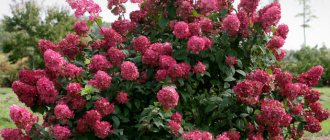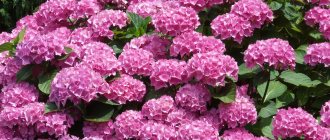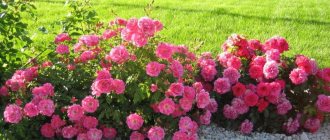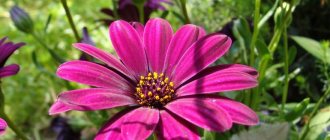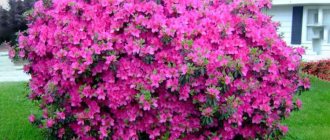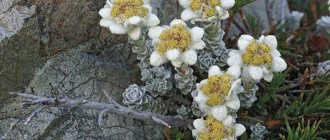Features and Specifications
There are many theories filled with romance and history about the origin of the name hydrangea. The Latin name comes from the Greek words “hydro” - “water” and “angelon” - “vessel”, since all types of hydrangeas need an abundance of moisture.
Hydrangea (lat. Hydrángea) is a genus of flowering plants in the Hydrangeaceae family, including approximately 80 species. The inflorescences of the shrubs consist of large flowers and have four sepals, which during flowering successively change color: green, white, then pink. These sepals act as bait for insects. In addition to the main ones, there are also small flowers that perform the function of reproduction (the so-called fertile sepals).
Among the hydrangeas there are shrubs (they make up more than 85% of the total) up to 3 meters high, about 15% are vines and trees.
The color of the inflorescences is varied. Often depends on the conditions of care, but white, red, pink, lilac and blue shades are known.
Distribution area: South and East Asia, America, in Russia - regions of the Far East.
Popular varieties of blue hydrangea
The most common types of large-leaved hydrangea are those with blue and blue flowers.
Blue Wave
It is a shrub with large, wide leaves. Peak flowering occurs in July-August. The color of the flowers ranges from pure white to pale blue, depending on the characteristics of plant care and genetic qualities. White flowers do not change color, but most other colors have the ability to change color.
Blueberry Cheesecake
The shrub is up to 120 cm high, has large flowers with a “double” surface and an intense purple color, often with a creamy-yellow border in the center. The leaves can change color: in summer they are dark green, and by autumn they become dark red.
Hydrangea Mini Penny
A compact shrub with a lush blue inflorescence can change color to delicate pink tones if special care conditions are met. The main positive quality is frost resistance and unpretentiousness.
Jomari
A shrub with a lilac-pink or lilac-blue inflorescence with the effect of a “terry” surface of the sepals and iridescent color. The flowering period is extended - from June to September. A huge plus: new inflorescences appear on new and last year’s branches.
Compeito
A hybrid variety from the land of the rising sun - Japan, literally translated the name means “hard caramel of bright colors.” Modified sepals of a blue or pink hue with a smooth, “caramel” shiny surface. Each shoot has 5-6 inflorescences up to 5 cm in diameter. The lateral surface of the leaves is ribbed with elongated edges.
Ramars
A low, moisture-loving shrub with bright, rich inflorescences: the most famous are dark blue, light blue, purple and violet flowers. The pleasing appearance is complemented by the multiple scalloped edges of the petals and the frame layering of inflorescences on the shoots.
Spike Blue
A shrub crop characterized by fairly rapid growth, a patterned frame and a “terry” leaf surface. The color of the inflorescences is deep crimson, they are distinguished by a special “lace” decoration. It is a remontant variety, so the flowers are located on current and last year's shoots.
Freedom
Compact but voluminous shrubs with shoots framed by finely defined petals of inflorescences. Unusual color of the leaves: the edges are painted in a delicate pale Creole shade, and the core is deep pink. A huge advantage is the special strength of the shoots, which protects garden crops from gusts of wind and strong rain streams.
Hopcorn Blue
One of the recently bred varieties of hydrangea is blue. This is a bush of moderate height with lush inflorescences collected in the form of “hemispheres” (or popcorn). Rounded petals of bright blue color give the plant a colorful look and create a pleasant decor for the garden. A special merit of the breeders is the high resistance of this species to fungal diseases.
The right time for change
The most suitable time for changing the color of garden hydrangea inflorescences can be considered autumn and early spring, before the buds appear. A flowering plant does not change the color of its petals. You will have to start the process of changing the color of the petals and soil parameters by determining the acidity (aka pH factor).
The paper changes color depending on the reaction of the environment. To determine it, you need to stir a lump of soil in a small volume of water and dip indicator paper into this solution. Having taken it out, you immediately need to compare the color it has acquired with the sample printed on the packaging, namely:
- if the indicator is 4 or less, the environment is very acidic;
- 4.5–5.5 – sour;
- from 5.5 to 6.5 – slightly acidic;
- 6.5–7 – neutral;
- more than 7 – alkaline.
If the indicator is above 6.5, the soil has a neutral or alkaline reaction, these ions are bound, the flowers of variable varieties of garden hydrangea will be pink.
Having determined the acidity, you can begin the procedure for changing it. The process can sometimes take several seasons. Sudden changes in soil acidity are undesirable for the plant and can affect its overall development, even cause its death. It must be taken into account that it is unrealistic to change the acidity throughout the entire area. If this process is suspended for some reason, the indicators will gradually return to the natural ones characteristic of the area.
At this time, it is necessary to carefully consider feeding the stressed plant. We must remember the effect of phosphorus on aluminum ions. It is impossible to completely eliminate an element necessary for normal development, but an excessive amount of it will make aluminum unavailable, and it will not be possible to obtain blue or dark blue flowers.
Planting and caring for blue hydrangea in open ground
When planting blue hydrangea in open ground, you need to know certain rules and provide appropriate care.
Selecting a planting site and preparing the soil
First of all, you need to choose a variety. Taking into account the characteristics of a certain type of hydrangea, you can begin to select the area: open sun on the site, partial shade or a shaded corner.
The choice of soil requires a detailed approach. It is imperative to determine the pH of the soil. After all, not only the growth of plants, but also the shade of the inflorescences depends on these indicators. Before planting, the soil should be fertilized with ready-made mixtures or prepared fertilizers yourself.
Criteria for soil readiness for planting:
- the soil must be well drained and moist;
- layers of planting soil have a certain ratio: humus, leaf soil, peat chips, river sand;
- pH level in the range of 5.0-5.2.
Planting a plant in open ground
The optimal depth of the hole is 60-65 cm. The soil must be thoroughly saturated with water, including the surrounding area. Cover the bottom of the hole with the prepared soil and lower the seedling into the soil, if you are using a seedling. The next mandatory step is abundant watering, manual compaction of the soil around the new planting and mulching; the choice of material for mulch remains with the gardener (peat, sawdust, tree bark).
It is worth considering the distance between plants if there are several seedlings: it should not be less than 1 meter. A denser planting of the crop contributes to excessive shading, increases competition between roots for moisture and interferes with the normal growth of hydrangea.
Caring for ornamental shrubs
Mandatory conditions for caring for hydrangea are weeding and loosening the soil. The frequency and volume of watering depend on the type of plant. To prevent excessive evaporation of moisture, the shrub is mulched.
Feeding hydrangeas occupies a key place in care: it is recommended to use complex fertilizers in the autumn, and in the spring to use a urea solution.
The correctness of care can be assessed during flowering - this will be evidenced by large leaves, inflorescences rich in shades and strong shoots.
Preparing for winter
Even the most unpretentious plant requires detailed and timely care for the winter. Although some varieties of hydrangea are frost-resistant, they need to be protected from the cold.
Trimming
After flowering, cut off all dry inflorescences on the shoots to reduce the weight of the branches in winter with the additional weight of snow and ice.
For all non-large-leaved species of hydrangea, autumn thinning pruning of shoots is mandatory. This approach allows you to get more lush inflorescences and shrubs for the next season.
Large-leaved varieties of garden crops require spring pruning, which is due to the characteristics of flowering on new and last year's shoots.
How to cover blue hydrangea for the winter
Frost-resistant varieties - tree and paniculata - are not covered, they are only lightly hilled in preparation for winter. Large-leaved varieties require careful protection from the oncoming cold, as they do not have sufficiently resistant qualities. To do this, use an air-dry shelter:
- the branches of the bush are tied and wrapped with spunbond;
- form a frame mesh around the plant;
- the cavity of the frame is filled with dry leaves to the very top;
- then, using any moisture-proof material, they form an additional cover for the bush.
After such actions, the shrub is ready for wintering.
Reproduction methods
A huge selection of blue hydrangea varieties determines the characteristics of reproduction. But still, gardeners identify five main methods:
- Cuttings . They use fairly large bushes from which green cuttings are taken. The resulting material is soaked in a solution of a growth stimulator and then rooted.
- Application of seeds . The process is lengthy, with many obstacles and difficulties. But with positive dynamics, you can get a large yield of seedlings. Frost-resistant varieties are sown directly in open ground during the period - late April - early May. Non-persistent types of hydrangea require planting seeds in a container.
- Reproduction by layering . Select bushes with an abundance of lower layers, then in a rut about 20 cm in diameter, dig in the middle of the shoot. The procedure is carried out in the spring, before flowering begins.
- Reproduction by offspring . Side shoots that have quickly grown a root system can be separated from the “mother” bush. This is done in the fall, before frost sets in. It is not recommended to plant “babies” in open ground, so they are left in pots until spring.
- Bush division . The most accessible method used when replanting a plant. Usually the bush is divided into 2-3 parts, but care is taken that each independent part contains a formed root system and several growth points.
Reproduction
Homemade hydrangea can be propagated by cuttings, layering, as well as dividing the bush and seeds. The latter method is ineffective, therefore it is used mainly by breeders to create hybrid varieties.
The easiest option is propagation by cuttings. To do this in the spring, you need to cut the shoots into small pieces of 8-9 cm so that there are 2-3 nodes on each. The cuttings are kept in a solution of “Kornevin” or any other root formation stimulator, then placed in the ground to form a root system.
A similar method is propagation by layering. In both cases, expanded clay, large pebbles, broken brick or any other drainage material should be poured onto the bottom of the planting container, and then covered with a substrate consisting of a soil mixture for ornamental plants and soil taken from under the pine tree (1 to 1) .
The growth of the root system begins in approximately 3-4 weeks. The easiest method of propagating hydrangeas is to divide the bush. It will require accuracy and certain planting skills.
An adult bush is divided into 2-4 parts so that each contains shoots with living buds and a sufficient number of roots. The roots must be shortened, placed in the ground, watered, covered with a greenhouse and left for active rooting. Plants tolerate root division best in the spring.
The following video will tell you how to care for indoor hydrangea.
Diseases and pests of blue hydrangea
The plant is often subject to white and gray rot. The disease affects the root system, leaves and stems, leaving perforations where the fungal mass lives.
Powdery mildew damages leaves, especially the border, causing rapid leaf loss.
But not only microflora can cause hydrangea diseases. Damaging factors also include:
- bright scorching sun;
- excessive or insufficient watering;
- lack of fertilizers;
- reduced soil acidity;
- low environmental humidity;
- insufficient iron content in the soil (chlorosis).
Do you like blue hydrangea?
Yes
No
Lighting
In summer, during the period of flowering and active growth, hydrangea should be placed in partial shade or in a place where the light is diffused. It is best for the flower when the top is illuminated and the stem and leaves are in light shade. Blue hydrangea does not tolerate directed sunlight, but very dark places are also not suitable for it. The flowering period comes later, and few inflorescences appear on the plant. In addition, lack of lighting causes the blue hydrangea to become weak. Do not allow the flower to come into contact with the glass. This will cause burns on the leaves.
How to change the color of a hydrangea to blue
The color of the inflorescence can be controlled. You can get the rich blue color of the petals only from large-leaved hydrangea. The color changes under the influence of soil pH, the level of aluminum compounds and minerals in the soil.
The petals will turn blue if three conditions are met:
- pH below 5.5;
- the presence of free aluminum, which is formed from its salts only in an acidic environment;
- minimum phosphorus content, since this macroelement promotes the reverse binding of aluminum in its salt.
Using hydrangea in landscape design
Thanks to the huge variety of varieties, colorful range of colors and abundance of forms, blue hydrangea has earned a place of honor in the works of landscape designers. Lush bushes and curled vines make up unique compositions in the works of masters. Designers give preference to varieties such as Pinky Winky, Anabelle, and Phantom. Hydrophilicity and love for shaded corners dictate the need to plant hydrangeas under the protection of structures and small buildings, which makes it possible to use trellises, fences, fences and steles in designer decorations.
The beauty of your favorite garden is reality, not fiction. The marvelous patterns of broad-leaved and “double” hydrangeas allow you to create contrast against the background of the bright colors of the inflorescences. By following a number of simple rules of care, you can get a brilliant garden that will delight you with flowering.
